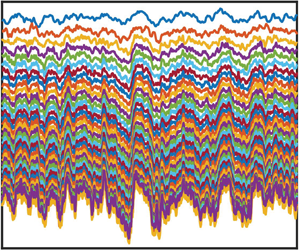Article contents
Synchronization of low Reynolds number plane Couette turbulence
Published online by Cambridge University Press: 17 December 2021
Abstract

We demonstrate that in plane Couette turbulence a separation of the velocity field in large and small scales according to a streamwise Fourier decomposition allows us to identify an active subspace comprising a small number of the gravest streamwise components of the flow that can synchronize all the remaining streamwise flow components. The critical streamwise wavelength,  $\ell _{x c}$, that separates the active from the synchronized passive subspace is identified as the streamwise wavelength at which perturbations to the time-dependent turbulent flow with streamwise wavelengths
$\ell _{x c}$, that separates the active from the synchronized passive subspace is identified as the streamwise wavelength at which perturbations to the time-dependent turbulent flow with streamwise wavelengths  $\ell _x<\ell _{xc}$ have negative characteristic Lyapunov exponents. The critical wavelength is found to be approximately 130 wall units and obeys viscous scaling at these Reynolds numbers.
$\ell _x<\ell _{xc}$ have negative characteristic Lyapunov exponents. The critical wavelength is found to be approximately 130 wall units and obeys viscous scaling at these Reynolds numbers.
JFM classification
- Type
- JFM Papers
- Information
- Copyright
- © The Author(s), 2021. Published by Cambridge University Press
References
REFERENCES
- 6
- Cited by





